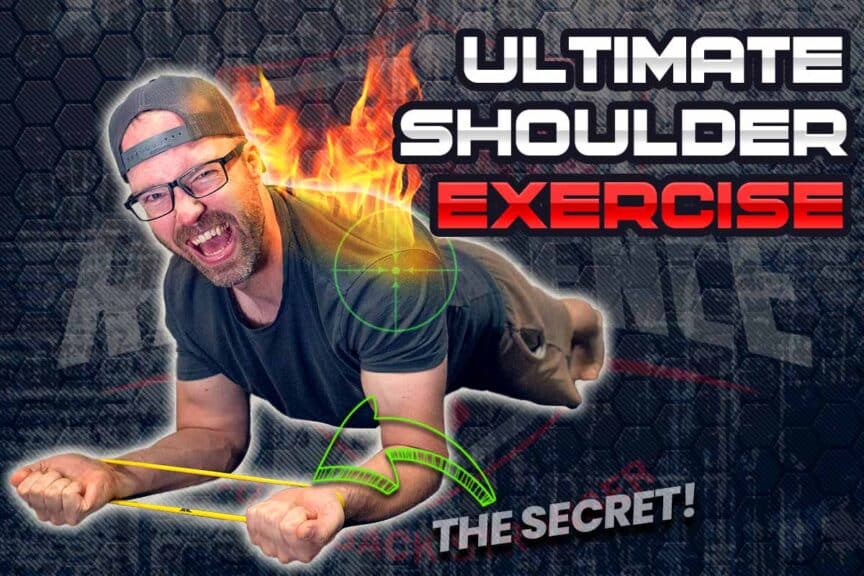There’s no shortage of plank and core stabilization exercises out there that you could opt for in your next workout. However, assuming you’re looking to get the most out of every exercise you perform, you’re about to learn one heck of a plank variation that will light up far more than your core muscles.
The plank variation I’m about to show you is a simple variation that will activate your rotator cuff muscles in a manner that optimizes shoulder health while you train your core. It can help with posture, prevent injuries, and reduce aches and pains associated with poor shoulder health.
This is a short article, so don’t worry; spend a couple of minutes reading about the two variations I’m about to walk you through, and you’ll be rewarded with two ways to optimize your shoulder health as you plank your little heart out.
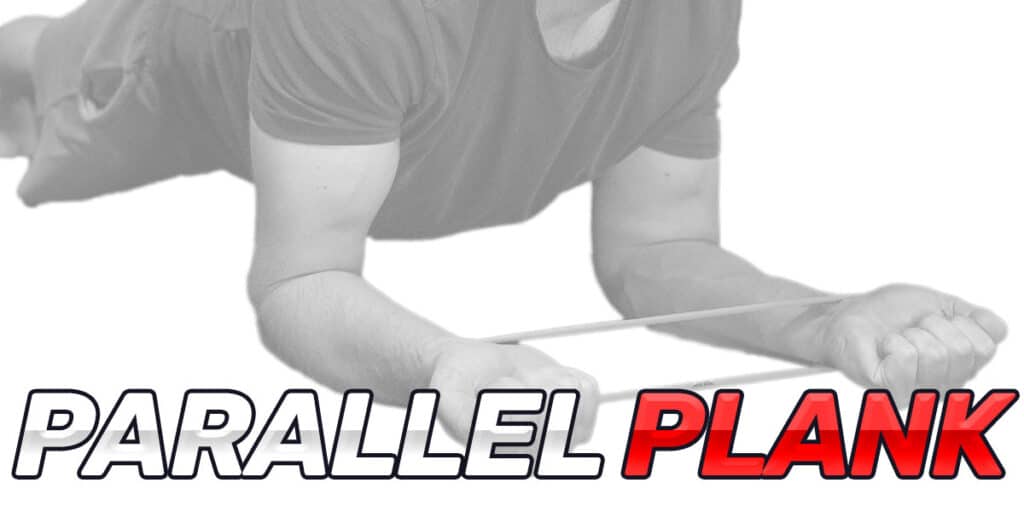
A small request: If you find this article to be helpful, or you appreciate any of the content on my site, please consider sharing it on social media and with your friends to help spread the word—it’s truly appreciated!
Yawn: The traditional plank
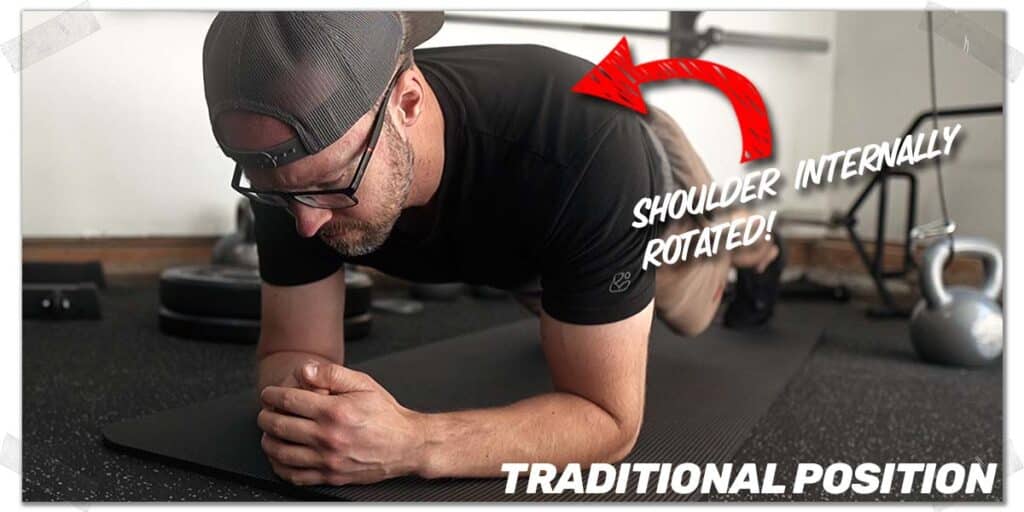
We all know the traditional plank: brace your core while clasping your hands together and holding this position for a pre-determined amount of time. Is there anything wrong with it? Not necessarily, but for many people, it reinforces a shoulder position that we already spend too much time in throughout the day.
This is an internally rotated position for the shoulders, which likely isn’t too challenging for you to hold and probably isn’t doing anything to help you optimize the functional health of your shoulders.
Think about the upper-body position we tend to hold when sitting at the computer desk or even standing—our shoulders tend to be slightly rounded forward (internally rotated). This means some of the muscles along the backside of the shoulder are chronically stretched out, leading them to become weak, interactive, and even painful.
“This plank can pay substantial dividends in preventing shoulder aches and pains that often arise when the rotator cuff muscles aren’t as strong and healthy as they should be.”
Naturally, devoting a bit of time and effort toward strengthening these backside muscles can help restore posture, increase their strength, and optimize function, all while reducing aches and pains. You can do this with numerous shoulder-specific exercises, which certainly isn’t a bad idea. But why not stimulate and challenge these muscles while holding the plank?
Moreover, why not give them a hefty isometric contraction to stimulate them? Keep reading if you want to know more.
Related article: Frozen Shoulder & Working Out: A How-to Guide (Detailed Article)
Benefits of the parallel-arm plank
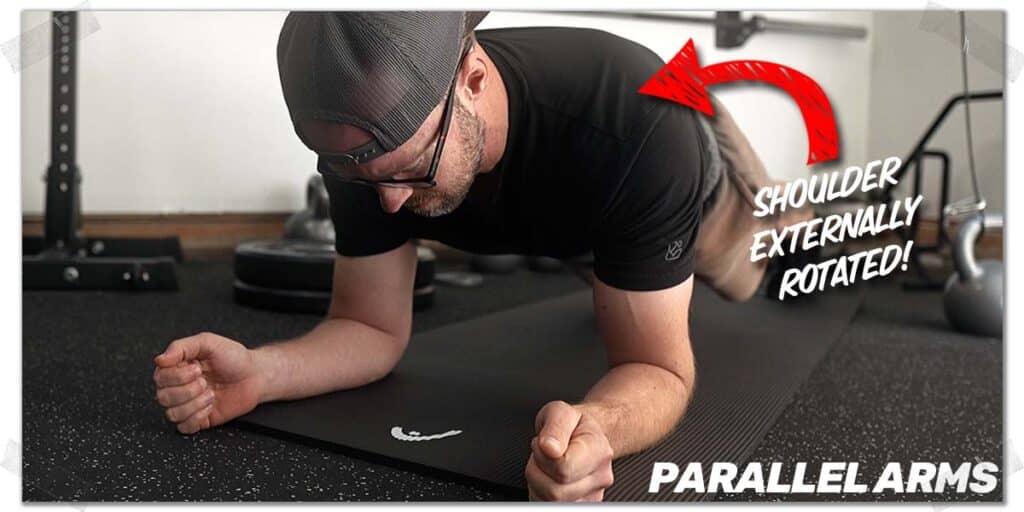
The concept here is simple: Light up your shoulders and increase their resiliency towards injury and dysfunction. All you need to do here is hold your plank while keeping your forearms parallel to each other. Everything else stays the same; hold the plank for however long you want (though you will very likely feel your shoulders start burning long before your core tires out).
Pro tip: There’s a more challenging version than this, which I’ll get to in a moment, but we need to start with the easier version before kicking it up a notch.
Supporting your bodyweight with your arms held in this parallel position creates a substantial challenge or stimulus to a few muscles that are critical for maintaining shoulder health and even assisting with posture. To move our arms into this position, we need to produce a movement called external rotation, which involves rotating the arms outward.
We’re highly interested in two particular muscles here for allowing this movement to happen. Particularly, we’re talking about the supraspinatus and teres minor, two of your rotator cuff muscles responsible for creating this external rotation movement.
“Naturally, devoting a bit of time and effort toward strengthening these backside muscles can help restore posture, increase their strength, and optimize function, all while reducing aches and pains.”
What’s so important about these muscles?
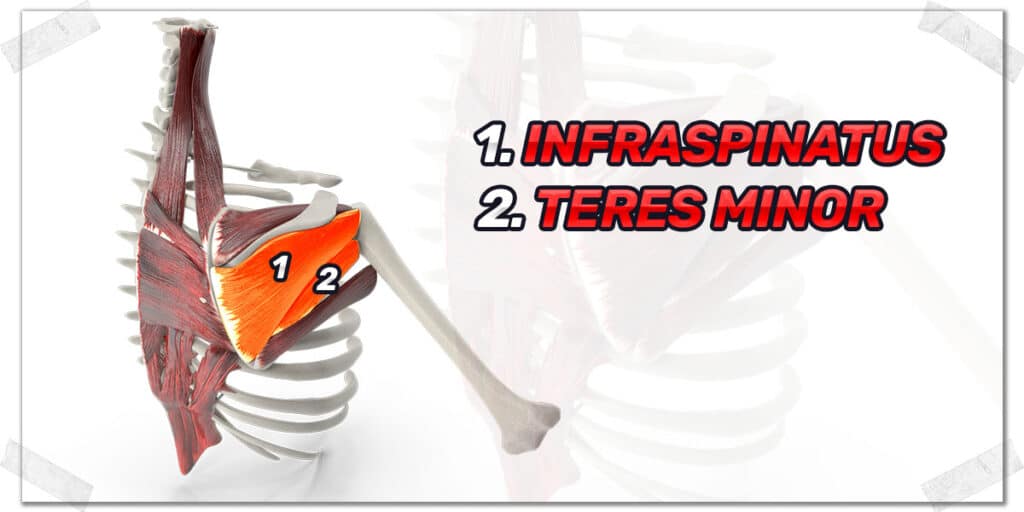
And the health of these muscles matters for numerous reasons. For brevity’s sake, let’s discuss the two most important reasons.
- The delicate nature of these muscles
- The functional nature these muscles provide
Regarding the delicate nature of these muscles, these are not the thick, chunky muscles that we often imagine them to be. They are, in fact, thin muscles that are rather susceptible to injury and dysfunction. Even worse, they are often significantly under-stimulated throughout our daily lives.
This unfortunate combination can lead to incredibly annoying and stubborn aches and pains that can really interfere with physical activities and even daily living, which lends itself to discussing the second point.
External rotation of the shoulder is a requisite movement for optimal daily function. We require the shoulder joint to move into this position to assist with numerous activities of daily living. The infraspinatus and its baby brother, the teres minor muscle, are the primary muscles that move the arm into this position. If they’re weak or dysfunctional, producing this movement becomes incredibly challenging and can interfere with our quality of life.
What should you feel with this plank?
As you spend a few moments in this parallel position, you’ll very likely start to feel the general backside of your shoulders burn or fatigue, which signifies that they’re working rather hard (i.e., getting stimulated) to keep you in this position.
If you typically don’t train these muscles as part of your fitness regimen, you’ll likely start to feel a notable sense of fatigue within thirty or so seconds. It’ll be different for everyone, but most folks with underactive external rotators will likely feel something within this amount of time.
Pro tip: Holding this position creates an isometric contraction for these muscles, meaning they aren’t producing movement but must remain in a contracted state. This type of muscle contraction can significantly help increase muscular endurance.
However…if you don’t feel this is enough of a challenge, the following variation will take care of this issue. Get ready for a gnarly burn unlike anything else.
Related article: Here’s How To Workout With Shoulder Bursitis (Do’s & Don’ts)
How to: Making this plank even harder

Alright, it’s about to get real. Let’s show you how to light up your infraspinatus and teres minor like you wouldn’t believe.
All you have to do here is take a fitness band (often called a mini-band) and loop it around your wrists. Then, hold your parallel arm plank position while keeping tension on the band as you hold your plank position.
The tension of the band will attempt to pull your shoulders inwards, forcing your external rotators to engage rather aggressively to prevent this from occurring. With enough tension on the band, your shoulders will likely be on fire in a matter of moments as they fight like crazy to hold their eternally rotated position.
Pro tip: You can fine-tune how challenging this banded variation is based on the resistance level of the band that you use. The greater the resistance, the more aggressively your shoulder muscles will have to work.
So, if it’s appropriate for you, give it a shot; it’s always a nice feeling to build a bulletproof set of shoulders while doing the same with your core as well.
Final thoughts
Ultimately, hold your plank however you want. It’s not that this is a magical plank variation that renders all other planks useless. It is, however, a plank that lights up the external rotator muscles of your shoulders while you challenge your core, packing a rather beneficial one-two punch for those who want to improve or maintain their shoulder health while doing the same with their core as well.
This can pay substantial dividends in preventing shoulder aches and pains that often arise when the rotator cuff muscles aren’t as strong and healthy as they should be.
Speaking of which, this article right here will show you another cool technique that can help you get some surprising benefits out of another common exercise with just a few minor and very simple tweaks.
And in the meantime, keep making great things happen.

Hi! I’m Jim Wittstrom, PT, DPT, CSCS, Pn1.
I am a physical therapist who is passionate about all things pertaining to strength & conditioning, human movement, injury prevention and rehabilitation. I created StrengthResurgence.com in order to help others become stronger and healthier. I also love helping aspiring students and therapists fulfill their dreams of becoming successful in school and within their clinical PT practice. Thanks for checking out my site!

